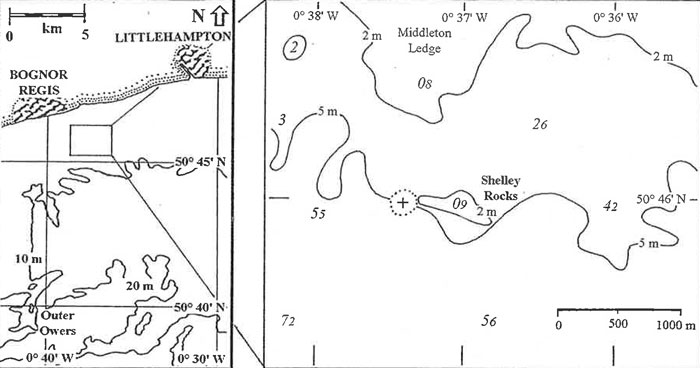SUSSEX MARINE SITES OF NATURE CONSERVATION IMPORTANCE
| Site: Shelley Rocks | Ref. No. 6 | ||||||
| Location: 2 km S of Middleton-on-Sea | Other conservation designation?: No |
||||||
| Lat./Long. position of centre of site: 50° 46' 0" N 0° 37' 0" W |
OS grid ref. of centre of site: SZ 975 955 |
Author: Robert Irving |
|||||
| Sea bed type: Mixed sediment of boulders, cobbles, gravel and sand. |
Depth range (below chart datum): 4-5 m |
Date identified: November 1995 |
|||||
Summary
Shelley Rocks comprises an extensive shallow area of bouiders, cobbles and a mix of gravel/sand/shell overlying chalk bedrock or exposures of grey clay. Mixed sediment areas such as these dominate much of the sea bed off West Sussex and this area has been selected on account of the wide range of sea bed types found in a relatively small area. Where these mixtures appear stable (from disturbance by wave action in particular), a rich variety of sessile animal species can occur. By contrast, where the ground is mobile, there are patches of clean gravel and pebbles with very little attached life present. The Shelley Rocks area appears to be a site of high deposition of silt from the water column.
Biological Description
The marine life associated with this site is typical of broken, mixed sediment grounds in shallow and medium depths. In general, the larger the particle size (and hence its greater stability), the greater the density and diversity of marine life associated with it. In shallow areas, kelp plants Laminaria digitata (and occasionally L. hyperborea and L. saccharina) may be found attached to larger cobbles. Strands of the bootlace weed Chorda filum are also likely to be found here. Other typical algae include Chondrus crispus, Plocamium cartilagineum, Palmaria palmata, Brogniartella byssoides and Halarachnion lingulatum. Algae may provide 80-90% cover of the sea bed during the summer months, though this cover decreases over winter as the fronds of many species decay. Occasional chalk cobbles and small boulders may be present, often with signs of boring organisms including piddocks, spionid worms and the sponge Cliona celata. Other, flint cobbles are dominated by growths of the 'leafy' bryozoan Flustra foliacea, the sea squirt Dendrodoa grossularia and the sponges Dysidea fragilis and Esperiopsis fucorum.
The areas of pebbles, gravel, shell and sand may be dominated by chains of slipper limpets Crepidula fornicata, with tubes of sandmason worms Lanice conchilega and stalked sea squirts Styela clava. Here too are found the dahlia anemone Urticina felina, less commonly the snakelocks anemone Anemonia sulcata, and patches of the reef-forming polychaete Sabellaria spinulosa. Mobile life includes hermit crabs (typically Pagurus bernhardus), the common whelk Buccinum undatum, the netted dogwhelk Hinia reticulata, small edible crabs Cancer pagurus, and occasionally shore crabs Carcinus maenas and spider crabs Maja squinado. Fishes to be seen include butterfish Pholis gunnellus, small juvenile gobies, and flatfish such as plaice Pleuronectes platessa and sole Solea solea. From February until April, lumpsuckers Cyclopterus lumpus come into these shallow waters to lay their eggs, which the males will guard for four weeks or more until they hatch. At the same time of year, cuttlefish Sepia officinalis may also be found here.
References:Irving, R. A. 1994. Report of the West Sussex Seasearch Project, 1992-1993: Chichester Harbour to Littlehampton Unpublished Report, Coldwaltham, West Sussex |
|||||||
| Sussex SEASEARCH dive nos.: 93/21-25 & 44 | |||||||
| Sussex Sublittoral Survey site no.: 11 | |||||||
Site Location

Diagrammatic representation of site: Shelley Rocks


:Link to this page
Copyright Sussex Biodiversity Records Centre © 2025